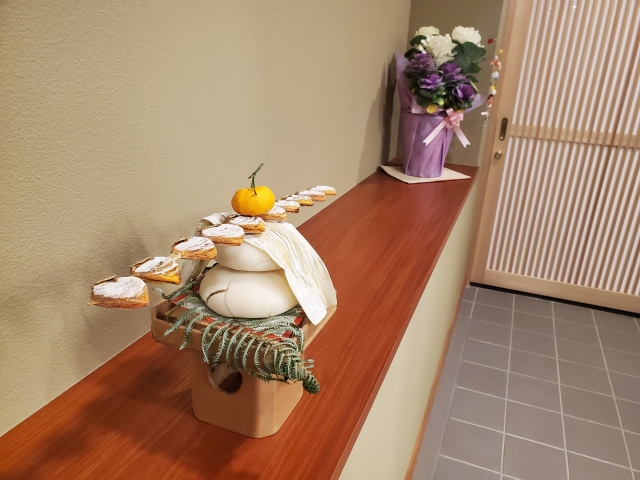Kagamimochi is a central part of Japan’s New Year celebrations. This traditional offering consists of two stacked rice cakes topped with a bitter orange (daidai), and it carries deep cultural and spiritual significance.
For many Japanese households, Kagamimochi is more than just a decoration—it’s a way to welcome Toshigami-sama, the deity of the new year, and pray for prosperity, health, and happiness in the coming year. But why is it shaped the way it is? Why does it include a daidai? And what role does the Sanpo stand play in its display? Let’s dive into the fascinating history and meaning of Kagamimochi.
What is Kagamimochi?

Kagamimochi is a traditional Japanese offering made of two round rice cakes stacked on top of each other, with the smaller one on top. Its design is simple but highly symbolic.
- The two tiers represent the past and the future, a way of connecting the blessings of previous generations with the hope for the year ahead.
- The daidai orange placed on top symbolizes longevity and continuity, as its name literally means “generation to generation.”
Kagamimochi isn’t just a decoration; it’s deeply tied to Japan’s spiritual customs and beliefs about starting the new year with gratitude and hope.
The History of Kagamimochi

The roots of Kagamimochi stretch back to the Heian period (794–1185). Originally, round rice cakes resembling mirrors were used as sacred offerings and were known as Mochikagami. Mirrors held profound significance in Japanese culture, representing purity and divinity.
During this time, it was believed that mirrors reflected one’s heart and could invite Toshigami-sama, the deity who brings blessings for the new year. Kagamimochi was seen as a way to honor this deity, ensuring good fortune for the household.
It wasn’t until the Muromachi period (1336–1573) that the practice of displaying Kagamimochi in the tokonoma (decorative alcove) became common, especially among samurai families. This tradition eventually spread to ordinary households, becoming a nationwide custom.
Nowadays you can buy Kagamimochi decorations at supermarkets!
So even if you have no time to make Kagamimochi, you don’t need to worry about it.



We have one, too!
This package contains everything and is so convenient!
This has real rice cake inside and you can enjoy oshiruko.

Rakuten Ichiba has Global Express and you can buy items from abroad.
Why is Kagamimochi Placed on a Sanpo Stand?

Kagamimochi is often displayed on a Sanpo, a traditional wooden stand used for offerings in Japanese rituals. The Sanpo not only elevates the Kagamimochi, but also enhances its spiritual significance.
The name “Sanpo” originates from its design, which features three open sides. These openings improve airflow while maintaining a symmetrical aesthetic that aligns with the meticulous attention to detail in Japanese traditions. By placing Kagamimochi on a Sanpo, the offering is given a sacred and respectful presentation, befitting its role in welcoming Toshigami-sama.
Kagamimochi at Taro & Otsuki family

We usually prepare Kagamimochi in December 30th.

My mother makes mochi, and we give it this shape.


We decorated the Kagamimochi with the plant “Urajiro”.
We also use this plant for Shimenawa.
Common Questions About Kagamimochi

- QWhen should Kagamimochi be displayed?
- A
Traditionally, Kagamimochi is displayed on December 28th. This date avoids bad luck associated with the numbers 29 (related to suffering) and 31 (too rushed).
- QWhen is Kagamimochi taken down?
- A
Kagamimochi is typically taken down and eaten on Kagamibiraki, celebrated around January 11th. This symbolizes breaking open the rice cake to share blessings.
- QCan Kagamimochi be reused?
- A
Fresh Kagamimochi is ideal, but in modern times, prepackaged versions with longer shelf lives are popular.
Conclusion : Let’s decorate Kagamimochi for New Year!
Kagamimochi is more than just a New Year decoration in Japan; it’s a bridge between the past, present, and future, a symbol of gratitude, and a prayer for blessings. Its rich history and intricate symbolism remind us of the importance of honoring traditions while embracing new beginnings.
So, the next time you see Kagamimochi, take a moment to appreciate the depth of its meaning and its role in welcoming the new year with hope and joy.

If you are interested in Japanese culture, you may love these games!
Let’s play!

Yes! Let’s play NIOH games!







Comments